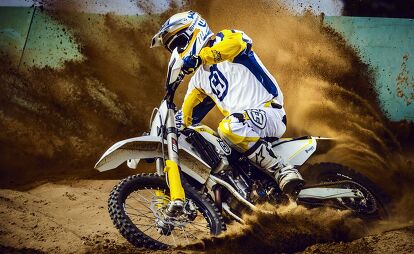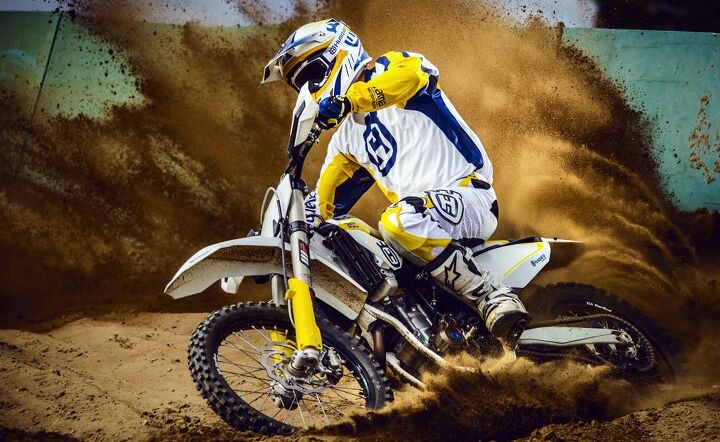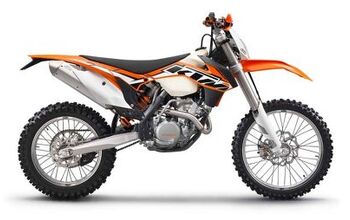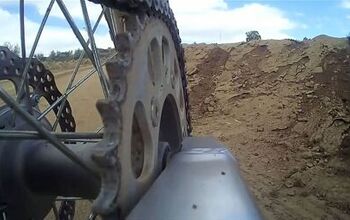Best Off-Road/DirtBike Of 2014
Off-road/Dirtbike of the Year Winner:
Yamaha YZ250F
In a class where keeping up with the latest technology can mean the difference between being on the podium and being left at the starting gate, Yamaha’s YZ250F was waaayy loooong overdue for an update in 2014. The Blu Cru’s quarter-liter four-stroke could do little more than hold its own against its rivals, suffering a power deficit and lacking a more precise and easier to tune fuel-injection system. If only Yamaha could come up with something more competitive while retaining the 250F’s excellent handling character…
Zizzap! Along comes the 2014 Yamaha YZ250F, with a trick, rear-incline engine layout that mimics its YZ450F sister, an all-new bilateral beam aluminum chassis and, yes, fuel injection. And all of this new trickery was available for just $7490, a mere two bills more than the previous YZ250F.
And don’t let that fancy, bass-ackwards motor fool you — Yamaha’s new 249cc engine is actually a little less complicated in some ways. For example, its symmetrical intake ports facilitate power production by giving the incoming fuel charge a straighter shot to the combustion chamber, and its new cylinder head now features four titanium valves instead of five. Sometimes simpler is better.
While it retains the same 77.0 x 53.6mm bore and stroke and 13.5:1 compression ratio of its forerunner, take one ride and you wouldn’t believe that the 2014 YZ250F shares any similarity with the 2013 model. The new motor rips with authority from bottom to top, with a bounty of torque and crisp throttle response that make it a blast to ride. The chassis delivers a happy combination of steering precision and stability, with comfortable ergos for those grueling, long motos. The suspension, punctuated by a KYB fork with Yamaha’s Speed Sensitive System damping cartridges, is excellent in rutted outdoor conditions or over supercross-style jumps.
When all was said and done, the YZ250F not only smacked down its motocross classmates in 2014, it proved to be the best of the best dirtbikes in the world, period.
Honorable Mention: Husqvarna
It is easy for the science geek in all of us to get so wrapped up in the performance data and specs of Motorcycle.com’s Best Of candidates that we might miss a truly great story that emphasizes the soul over the statistics, the cool factor over cold facts. The revival of Husqvarna in 2014 (you can insert any and every model in the company’s current lineup right here) is one of those stories.
To appreciate the impact of Husqvarna’s purchase from BMW by the same folks who run KTM, one must understand two things. First, even with BMW’s financial might, Husqvarna was likely headed down a path to destruction from which it might disappear for good. BMW’s Teutonic philosophy simply didn’t mix well with Husqvarna’s impassioned fan base, and experimenting with out-of-sync technologies such as pivotless swingarm designs on Husky models was going to do little to get their attention. Husqvarna is a racing brand. And credit Munich for realizing that and finding a new suitor for the Husky brand before it was too late.
Second, KTM had very little to gain and potentially much to lose by purchasing Husqvarna and actually building and selling motorcycles with the Swedish crown on their flanks. We should be thankful that KTM gets it. Like Polaris did with Indian, the Austrian company understands the value of restoring a brand with a Biblical legacy, even at the potential expense of market share with its existing model lines.
And that restoration is underway. A complete line of Husqvarna motocross and off-road two-stroke and four-stroke models debuted in 2014, supported by fully funded factory race teams that contest just about every major motocross and off-road series in America, as well as the rest of the world. That effort has already yielded results, with Husqvarna’s U.S. race teams garnering the brand’s first AMA National Hare & Hound and AMA National Enduro wins since the late 1980s. Just last weekend, Husqvarna earned its first FIM Enduro World Championship since 2003, with France’s Pela Renet. Such victories could not be earned if the machines themselves were not up to the task.
Alas, ye of cold heart might just dismiss Husqvarna’s revival by claiming that the “new” Husqvarnas are simply KTMs with white plastic. That semi-truth would ignore one important fact, however: If not for Husaberg, KTM might have taken a lot longer to become the off-road world power that it is today. KTM’s four-stroke off-road machines borrowed an awful lot of technology from the Swedish brand after KTM purchased it in the mid-1990s. And what was Husaberg but a holdout team of Swedish engineers who refused to move to Italy after Cagiva purchased Husqvarna in 1986?
Thanks to KTM, the Husqvarna brand is not only surviving, it is thriving for the first time in decades. So, maybe both brands deserve our honorable mention here.
Motorcycle.com Best of 2014 Categories
More by Scott Rousseau

































Comments
Join the conversation